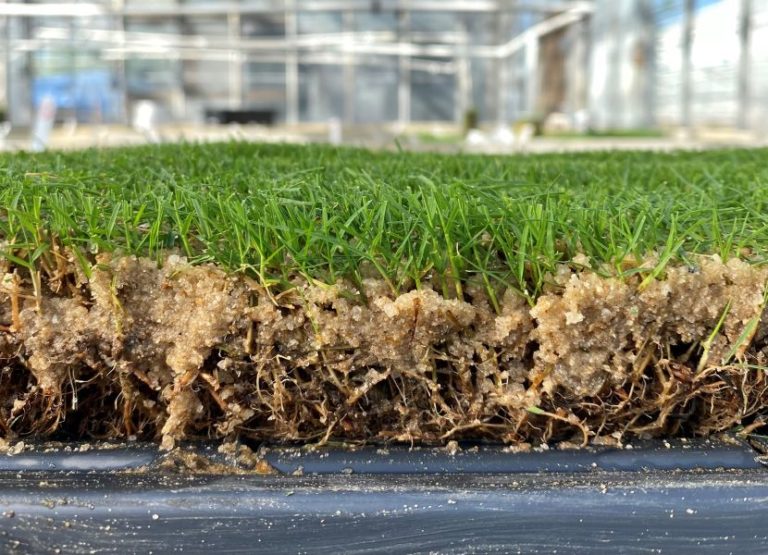By Jose Diaz, Benjamin Wherley, Ph.D., and Chase Straw, Ph.D., Texas A&M University
Thick-cut, plastic grown sod (PGS) demand for midseason repair or complete renovation of professional and collegiate sports field venues has increased dramatically. However, published information on best practices for PGS development is lacking. Furthermore, there has been very little prior research done to examine cultural factors relating to rate of establishment and final quality of PGS. Therefore, the objective of this study was to evaluate the influence of cultural practices (e.g., mowing frequency, topdressing particle size, and plant growth regulator) on establishment, tensile strength, and root/rhizome development of plastic-grown ‘Latitude 36’ hybrid bermudagrass sod.
The study was conducted March 2 through June 24, 2021 in a greenhouse at Texas A&M University in College Station, Texas, using washed ‘Latitude 36’ bermudagrass sod placed in plastic trays. A randomized complete block design with four replications was used to accommodate all cultural practice treatment combinations, including mowing frequency (one vs. three times a week), topdressing sand particle size distribution (medium fine = 0.05 to 0.5 mm vs. medium coarse = 0.5 to 1 mm sand), and plant growth regulator [trinexapac-ethyl applied every 14 days at label rate (Primo Maxx) vs. no trinexapac-ethyl]. At the beginning of the study, all treatments received a micronutrient fertilizer application, and trays were fertilized monthly through the study using a 10-20-20 granular fertilizer at rate of 0.67 lb. N/1,000 sq. ft. Topdressing treatments were applied by hand at a depth of 0.1 inch every 14 days. Trays were irrigated daily with overhead mist irrigation at a depth of 0.25 inches, divided into two split-applications per day.
Visual turf quality (1-9 scale, 6 = minimal acceptable) and light box images were collected every week. Soil volumetric water content for the upper half inch was also measured weekly. At the conclusion of the 16-week study, sod trays were allowed to drain overnight and were weighed to determine final mass. Sod tensile strength was then measured for all treatments using a tensile strength testing device with electric winch and Transcell TI-500E load cell. Root length density attributes for each treatment were also characterized using WinRhizo to relate to tensile strength differences. Root and rhizome dry mass were determined for two, four-inch-diameter plugs removed from each sod piece.
All treatments maintained excellent visual turf quality throughout the duration of the study (8.1 average across all treatments). The medium-fine sand resulted in higher turf quality (8.2) than coarse sand when mowing was performed 1x weekly (8.0). When topdressed with medium-fine sand, the 1x weekly mowing treatment led to significantly higher sod strength (344 N) compared to 3x weekly mowing (225 N). Bi-weekly PGR application resulted in significantly greater root dry weight (5.4 g) compared to non-PGR-treated sod (4.1 g). Trinexapac-ethyl also improved turf quality (8.2 vs. 8.0 for treated and untreated sod, respectively). Final plastic grown sod mass ranged from 1.37 g cm-3 (coarse sand) to 1.44 g cm-3 (medium-fine sand) but did not statistically differ. Root length density of plastic grown sod in this study was much higher than that of previously published field-grown turf, averaging 70 cm cm-3, but no differences were seen among treatments.
The study is currently being repeated. At the conclusion of the study, principal components analysis will be utilized to determine the relative contributions of cultural and plant developmental factors to sod strength.


